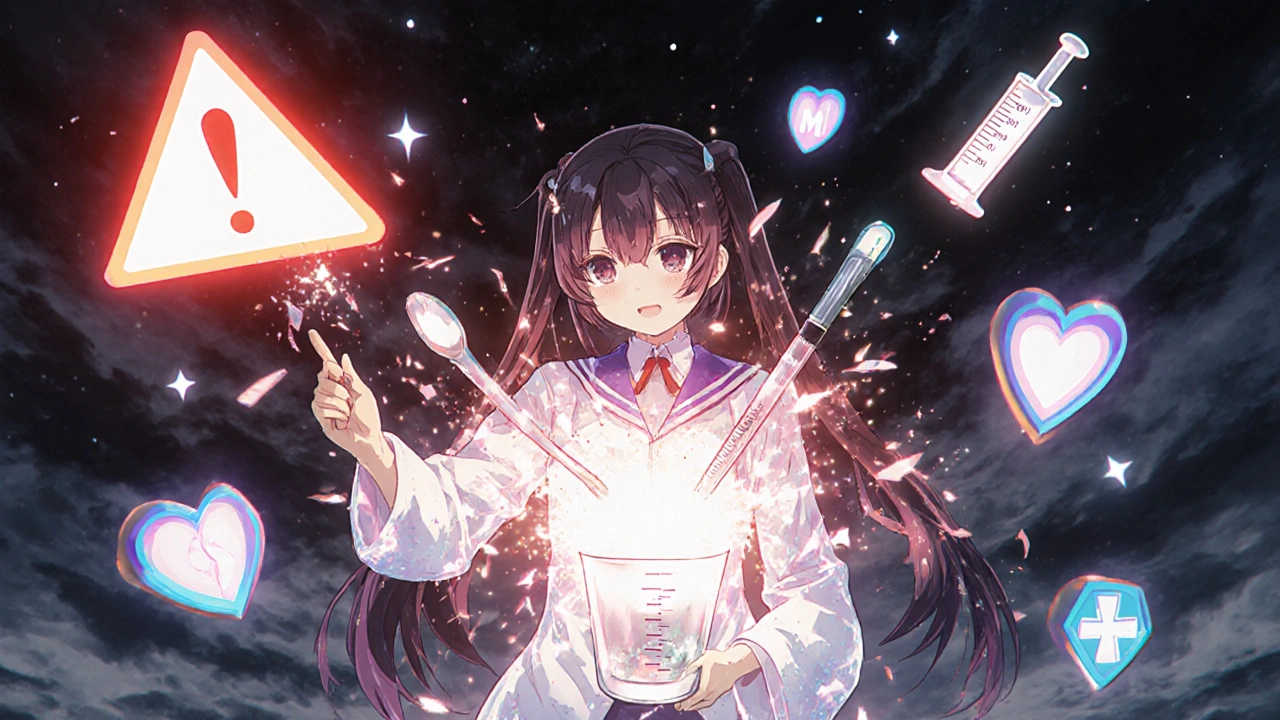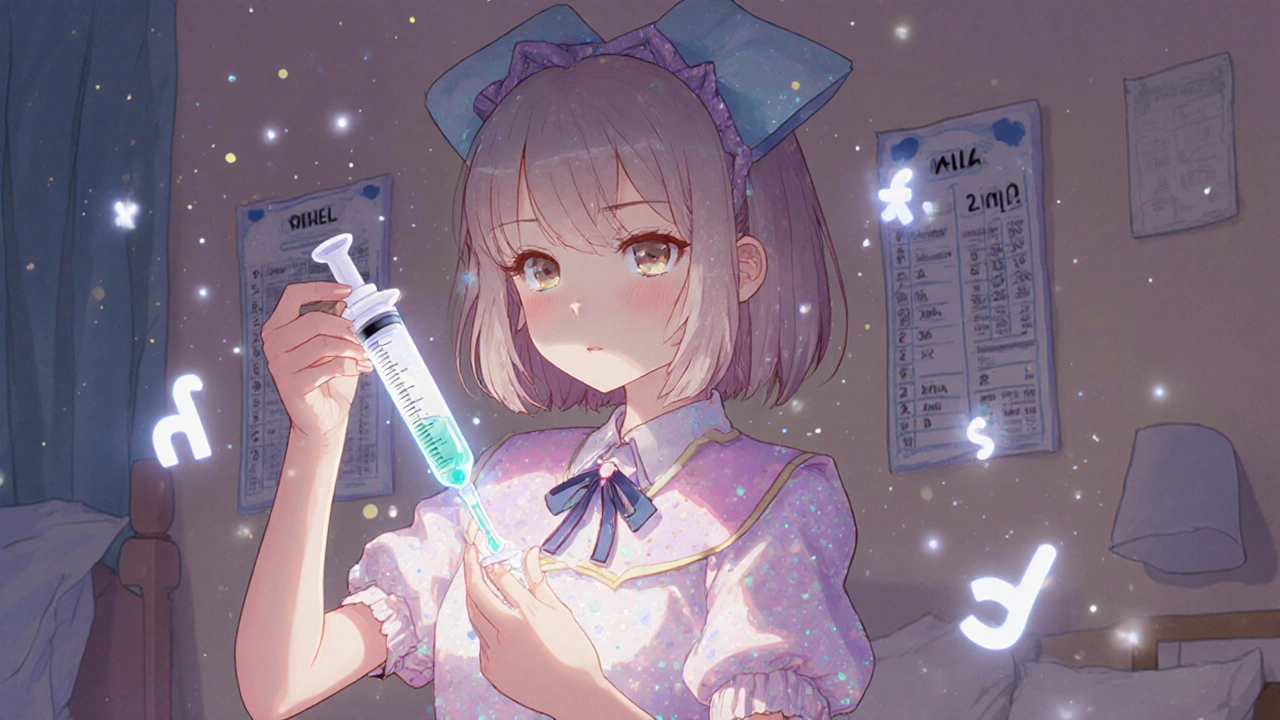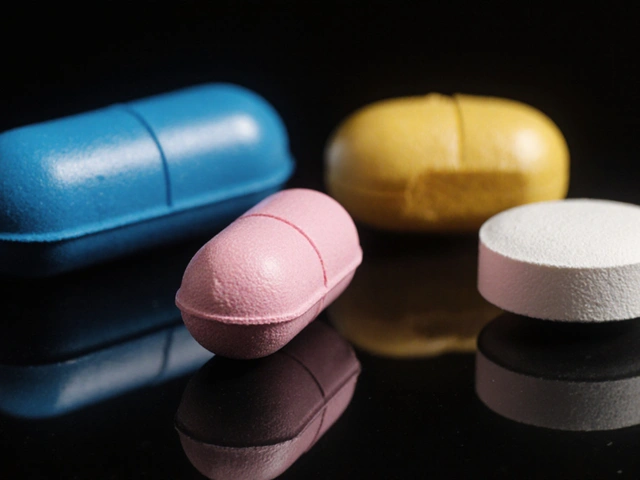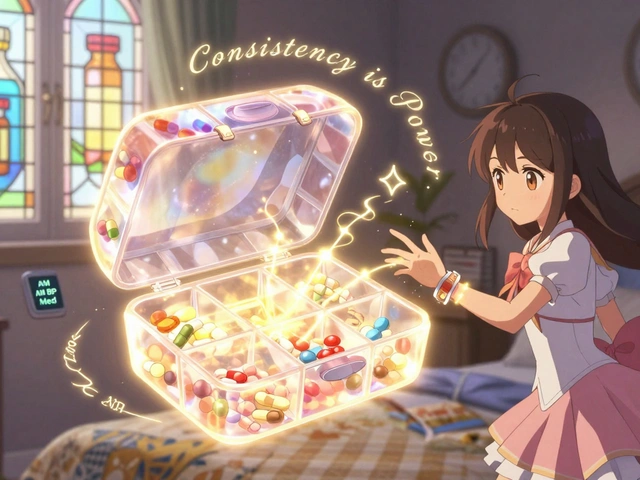Getting the right dose of medicine for your child isn’t just important-it can be life-saving. A mistake of just one milliliter can mean the difference between a child getting better or ending up in the emergency room. And it’s not rare. Studies show that 7 in 10 parents mess up liquid medication doses at home, often because they’re using the wrong tools or misunderstanding the labels. This isn’t about being careless. It’s about confusion. The system is built to trip people up. But you don’t have to be part of the statistic.
Why Milliliters (mL) Are the Only Measurement That Matters
Forget teaspoons and tablespoons. They’re not accurate. A kitchen teaspoon can hold anywhere from 3.9 to 7.3 milliliters. That’s a 50% error right there. For a child, that’s dangerous. A dose meant to be 2.5 mL could become 4 mL-or worse, 7 mL. That’s not a little extra. That’s a potentially toxic amount of medicine.
The Centers for Disease Control and Prevention (CDC) and the American Academy of Pediatrics (AAP) have been clear since 2015: only use milliliters (mL). No more tsp, tbsp, or ‘a capful.’ All prescriptions should be written and labeled in mL only. If you see a label that says ‘1 teaspoon,’ ask the pharmacist to rewrite it in mL. You have the right to ask. And if the bottle doesn’t come with a proper measuring tool, ask for one.
The Right Tools for the Job
Not all measuring tools are created equal. Here’s what works-and what doesn’t.
- Oral syringes (1-10 mL): These are the gold standard. They’re precise, easy to control, and let you give the exact dose. Use them for doses under 5 mL. They’re especially critical for antibiotics, pain relievers like acetaminophen, and medications with a narrow safety margin like seizure drugs or heart medications.
- Dosing cups (5-30 mL): These are okay for older kids who can drink from a cup, but they’re error-prone for small doses. If you’re giving 2.5 mL, the cup’s markings are too far apart. You’ll guess. And guessing kills.
- Droppers: These are fine for newborns or tiny doses under 2 mL. But they’re hard to read and easy to spill. Make sure the dropper came with the medication-don’t reuse one from another bottle.
- Household spoons: Never use them. Not even if your grandma says it’s fine. A dinner spoon can hold up to 15 mL. That’s three times a single dose.
Studies show oral syringes reduce dosing errors by 42% compared to cups. For doses under 5 mL, the error rate drops from 68.5% with cups to just 12.3% with syringes. That’s not a small difference. It’s the difference between safety and danger.
How to Use an Oral Syringe Correctly
It’s simple-but most people do it wrong.
- Shake the bottle first. Liquid meds like antibiotics are suspensions. The medicine settles at the bottom. If you don’t shake it, you might give your child mostly water. One study found 30-50% of parents underdose because they skip this step.
- Draw up the dose slowly. Insert the syringe into the bottle. Pull the plunger until the top of the black line matches the dose (e.g., 3.5 mL). Don’t eyeball it.
- Hold it upright. Look at the syringe at eye level. The liquid forms a curve (called a meniscus). Read the dose at the bottom of that curve.
- Give it slowly. Gently squeeze the plunger and aim the tip toward the inside of your child’s cheek, not the front of the mouth. This reduces spitting and gagging.
- Wash and store it properly. Rinse with water after each use. Don’t let it sit dirty. Store it in a clean, dry place-not in the medicine cabinet where it might get mixed up with other tools.
Pro tip: Use a permanent marker to write the dose on the syringe if you give the same amount every day. For example, write ‘2.5 mL’ next to the plunger. It helps when you’re tired or stressed.

Weight Matters: Calculating the Right Dose
Most children’s meds are dosed by weight-not age. That means you need to know your child’s weight in kilograms (kg), not pounds (lb).
Here’s the math: 1 kg = 2.2 lb. So if your child weighs 22 pounds, divide by 2.2. That’s 10 kg.
Now look at the prescription. Say it says: “Amoxicillin 40 mg/kg/day in two divided doses.” That means 40 mg per kg, twice a day.
- 10 kg × 40 mg = 400 mg total per day
- 400 mg ÷ 2 = 200 mg per dose
If the medicine is 400 mg per 5 mL, then 200 mg is half of that-so 2.5 mL per dose.
Don’t guess. Do the math. Write it down. If you’re unsure, call the pharmacy. Pharmacists are trained for this. They expect these questions.
What to Do When Your Child Refuses Medicine
Most kids hate the taste. That’s normal. But hiding it in juice or milk can be risky. Some meds lose effectiveness when mixed. Others can be absorbed too quickly.
Safe tricks:
- Use a syringe to squirt the medicine into the side of the mouth, near the cheek. It bypasses the tongue, where taste buds are strongest.
- Offer a cold spoon of apple sauce or yogurt right after. The taste masks the medicine.
- Ask your pharmacist if a flavored version is available. Many pharmacies can compound meds with fruit flavors.
- Don’t force it. If your child vomits within 15 minutes, call the doctor. Don’t give another dose unless told to.
Common Mistakes (And How to Avoid Them)
Here’s what goes wrong-and how to fix it:
- Mixing up mg and mL: One is a unit of weight (milligrams), the other is volume (milliliters). They’re not the same. A 5 mL dose of medicine might contain 125 mg or 250 mg-check the concentration on the bottle.
- Using the wrong syringe: Don’t use a 1 mL syringe to measure 7 mL. Use the right size. If you need 6 mL, use a 10 mL syringe. It’s easier to read.
- Not checking the concentration: Amoxicillin can be 125 mg/5 mL, 250 mg/5 mL, or 400 mg/5 mL. The dose changes completely. Always read the label.
- Sharing dosing tools: Never use a syringe from another child’s medicine. Even if it looks clean, it could be contaminated or mismatched.
- Assuming the cup is accurate: If the bottle came with a dosing cup, use it. But if you’re giving less than 5 mL, switch to a syringe. Always.

Special Cases: High-Risk Medications
Some medicines are dangerous if given wrong-even by a tiny amount. These include:
- Digoxin (heart medicine)
- Warfarin (blood thinner)
- Levothyroxine (thyroid hormone)
- Chemotherapy drugs
For these, always use an oral syringe. Never rely on a cup. Double-check the dose with your pharmacist. Keep a written log of each dose and time. If you’re ever unsure, don’t give it. Call your doctor.
What to Do If You Make a Mistake
Accidents happen. You gave 5 mL instead of 2.5 mL. Or you gave the wrong medicine. Don’t panic. Don’t wait.
Call your pediatrician or poison control immediately. In New Zealand, call 0800 764 766 (Poison Centre). In the U.S., call 1-800-222-1222. Have the medicine bottle with you. Tell them:
- What medicine was given
- How much was given
- When it was given
- Your child’s weight and age
Most errors don’t cause harm-but you need to know. Don’t wait for symptoms.
Final Tips for Everyday Safety
- Always use the measuring tool that came with the medicine. Don’t substitute.
- Keep all medicines out of reach-not just for kids, but for visitors or caregivers who might not know the right dose.
- Write down the dose, time, and date in a notebook or phone app. It helps avoid double-dosing.
- If you have multiple caregivers, make sure everyone uses the same tool and method. A grandmother using a spoon and a parent using a syringe creates chaos.
- Ask for a dosing chart from your pharmacy. Many now offer simple charts for common meds like acetaminophen based on weight.
Medication safety isn’t about being perfect. It’s about being careful. One extra second checking the label, one more time reading the syringe, one more call to the pharmacist-it adds up. And it saves lives.
Can I use a kitchen spoon to give my child medicine?
No. Kitchen spoons vary in size and are not accurate. A teaspoon can hold anywhere from 3.9 to 7.3 milliliters, while a standard teaspoon is meant to be exactly 5 mL. Using a kitchen spoon risks giving your child too much or too little medicine, which can be dangerous. Always use the measuring tool that comes with the medication-like an oral syringe or dosing cup marked in milliliters (mL).
What’s the difference between mg and mL on a medicine label?
Milligrams (mg) measure the amount of active drug in the medicine. Milliliters (mL) measure the volume of liquid. For example, a bottle might say ‘125 mg per 5 mL’-meaning every 5 mL of liquid contains 125 mg of medicine. You need to know both to calculate the right dose. Never confuse the two. Giving 5 mL of a 125 mg/5 mL medicine is correct. Giving 5 mg instead of 5 mL could be a 25-fold error.
Why is an oral syringe better than a dosing cup?
Oral syringes are more accurate, especially for small doses under 5 mL. Studies show dosing cups have a 68.5% error rate for 2.5 mL doses, while oral syringes have only a 12.3% error rate. Syringes let you draw up the exact amount and deliver it precisely into the mouth. Dosing cups are harder to read for small volumes and are more likely to be spilled or misread.
How do I convert my child’s weight from pounds to kilograms?
Divide the weight in pounds by 2.2. For example, a child weighing 22 pounds is 10 kilograms (22 ÷ 2.2 = 10). Most children’s medications are dosed in mg per kg, so you need this number to calculate the correct dose. Always double-check your math or ask your pharmacist to confirm.
What should I do if my child spits out or vomits the medicine?
If your child spits out the medicine before swallowing, you can give another full dose. If they vomit within 15 minutes of taking it, call your doctor before giving another dose. If they vomit after 15-30 minutes, the medicine may have been absorbed, so don’t repeat the dose unless instructed. Never guess-always check with a healthcare provider.






Comments
Chrisna Bronkhorst
November 13, 2025 AT 14:31 PMStop using spoons. Period. I’ve seen moms try to wing it with a soup spoon because ‘it’s just a little extra.’ That’s how kids end up in ICU. Oral syringes cost like $2 at Walmart. Use them.
Amie Wilde
November 14, 2025 AT 09:14 AMThey dont even include syringes anymore. Pharmacies are cutting corners. I had to buy my own for my 2yo. No joke.
Gary Hattis
November 14, 2025 AT 10:55 AMAs someone who grew up in a household where medicine was measured with a kitchen spoon, I can tell you this is life-saving info. My cousin got hospitalized because his grandma gave him ‘a full spoon’ of amoxicillin. He was 3. We didn’t know better. Now I carry a syringe in my diaper bag like a weapon. No shame.
Also, shaking the bottle? Game changer. I used to just pour and pray. Now I shake like I’m trying to start a car. 30 seconds. No excuses.
And yes, weight in kg. I used to guess based on age. Bad idea. My daughter’s dose changed completely when we switched from 25 lbs to 11.3 kg. Pharmacy saved us. They’re not there to judge. They’re there to help.
Also, writing the dose on the syringe? Genius. I did it with a Sharpie. Now even my exhausted 3am self doesn’t mess it up.
And don’t even get me started on mixing meds with juice. My kid threw up for an hour because I put Tylenol in apple juice. Turns out it makes the medicine clump. Now I use a syringe + cold yogurt. Works every time.
Also, if you’re using a dosing cup for under 5mL, you’re gambling. I’ve seen the markings. They’re useless. Syringe or nothing.
And yes, digoxin, warfarin, levothyroxine - those are landmines. I don’t even trust myself with those. I write it down, double-check with the pharmacist, and take a picture of the label. I’m not brave. I’m smart.
And if you make a mistake? Call poison control. Don’t wait. Don’t Google it. Don’t hope it’s fine. Just call. It’s free. It’s 24/7. It’s your lifeline.
This isn’t paranoia. This is parenting. One extra second saves a life.
Esperanza Decor
November 14, 2025 AT 20:45 PMI used to think I was being careful until I realized I was using the same syringe for my kid’s antibiotics and my husband’s allergy meds. I cleaned it, but still. Never again. Now each med has its own syringe, labeled with a sticker. It’s a tiny thing, but it’s peace of mind.
Also, the meniscus thing? I had no idea. I was reading the top of the liquid. That’s why I kept giving too much. Now I crouch down, eye level, bottom of the curve. It’s weird but it works.
And yes, pharmacies can flavor meds. I got my kid’s amoxicillin in bubblegum. He actually asked for it. No joke.
One more thing - write down the dose and time. I use a sticky note on the fridge. My husband and I both see it. No double-dosing. No arguments.
Deepa Lakshminarasimhan
November 15, 2025 AT 03:40 AMDid you know the FDA doesn’t require syringes to be included anymore? It’s all about cost-cutting. Pharmacies make more money selling you a dosing cup. They don’t care if you mess up. Big Pharma wins. You lose.
And why do labels still say ‘teaspoon’? Because they know people are dumb. They’re counting on it. Don’t fall for it.
I think this whole system is designed to fail parents. They want us to be confused. Then we blame ourselves. But it’s not us. It’s the system.
I only trust the pharmacist. And even then, I cross-check everything. I’ve seen too many kids hurt because ‘everyone does it this way.’
Erica Cruz
November 16, 2025 AT 06:20 AMThis post is so basic. Like, really? We’re still talking about teaspoons? I’m shocked anyone over 25 doesn’t know this by now.
Also, why is this even a thing? The CDC has been screaming about this since 2015. If you’re still using a spoon, maybe don’t have kids.
And the weight conversion thing? I mean, it’s 2.2. It’s not rocket science. If you can’t divide by 2.2, maybe hire a babysitter who can.
Also, why are you even reading this if you’re using a kitchen spoon? Just… stop.
Johnson Abraham
November 17, 2025 AT 00:04 AMbro i just use the cap lol. its fine. my kid still alive. u guys are overthinking this. 1 cap = 1 cap. who cares if its 4ml or 7ml? they gonna be fine. also why u gotta write on the syringe? its not a math test.
also why u gotta shake it? its just medicine. not a soda. lol
my grandma gave me medicine with a spoon and i turned out fine. u all are too scared.
Shante Ajadeen
November 17, 2025 AT 21:36 PMThank you for this. I’m a single mom and I was terrified every time I gave medicine. I didn’t know about the meniscus or the shaking. I thought the cup was fine. Now I use the syringe, write the dose down, and I sleep better.
Also, the flavored med tip? Lifesaver. My kid used to cry for 10 minutes. Now he takes it like candy. I didn’t even know pharmacies could do that.
And yes - if you’re unsure, call the pharmacy. They’re not busy. They want you to be safe. I’ve called three times. Never once felt judged.
You’re not alone. We’re all figuring this out.
dace yates
November 18, 2025 AT 23:13 PMIs this true for all countries? I’m in the US but my sister lives in India and she uses a spoon because that’s all they have. Do the same rules apply?
Danae Miley
November 20, 2025 AT 07:25 AMCorrection: The CDC and AAP recommend mL-only labeling, but many manufacturers still print ‘teaspoon’ alongside mL due to legacy packaging standards. You must request mL-only labeling - it’s your legal right under the FDA’s 2015 Medication Error Prevention Guidelines. Don’t accept anything less.